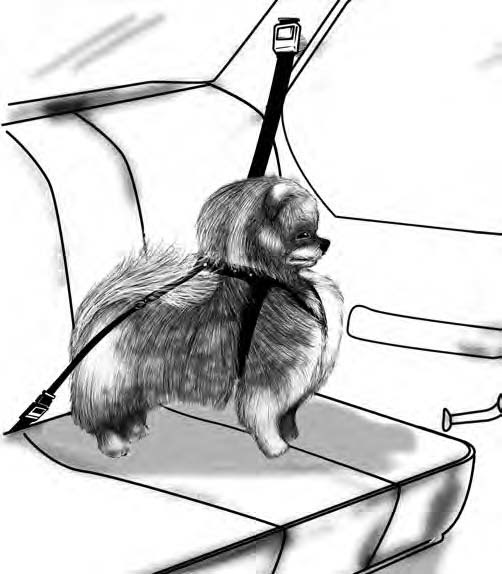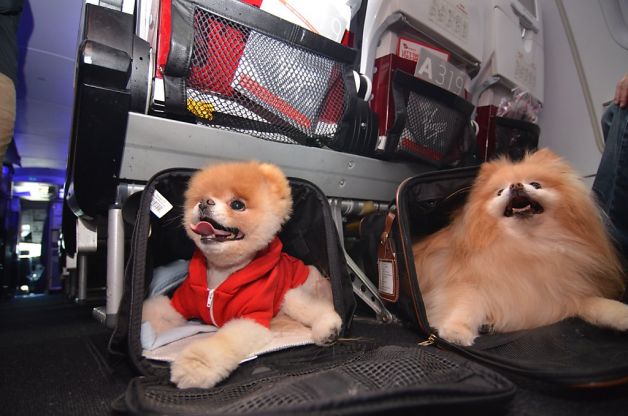In This Chapter
- Making a list, checking it twice: Must-have items for a trip
- Adjusting for your pup’s needs: Safety, temp, and comfort
- Gaining altitude: Your pup in flight
- Treating the motel well
- Choosing a caregiver when your pup must stay home
Remember
Without planning, though, traveling with a dog can be a hassle. You can find yourself turned away from motel after motel or paying expensive pet fees. You may not be able to take him to many of the attractions on your list, and in warm weather, you may have to skip shopping altogether because it’s too hot to leave him in the car. You may also start to describe your sightseeing as drive-bys, as in “I drove by this” and “I drove by that.”
Packing for Your Pomeranian
– Basic grooming equipment
– Bed
– Bottled water or water from home (strange water can sometimes cause diarrhea)
– Bowls for food and water
– Bug spray or flea spray
– Chewies and interactive toys to pass the time
– Flashlight for late-night walks
– Food (if you use cans, get the pop tops or bring a can opener)
– Identification tags
– Medications including antidiarrheal medication and possibly his monthly heartworm preventive; also, motion-sickness pills if your dog suffers from that malady
– Paper towels, moist towelettes, and rinse-free shampoo for that carsick thing
– Plastic baggies or other poop-disposal tools
– Rabies certificate (some places require them)
– Recent color photo in case he gets lost
– Short and long leashes
– Towels (figure on one or two a day, including one to place over his bedding in the crate in case he gets carsick)
– Travel crate or (second choice) doggy seatbelt
Hitting the Road
Practicing safety first
Remember
Take the same care to ensure your Pom’s safety, whether traveling cross-country or just to the store. Although using a crate may seem to take some of the fun away, traveling within a secured crate (either attached to a seat belt or to some solid part of the car) has saved many canine lives. Besides, you don’t need a dog jumping on your lap or checking out the driver’s seat floor while you’re driving.
Remember
Although the thought is unpleasant, preparation for a problem is key. What if you had an accident and couldn’t speak for your injured dog? As an extra safety measure, place emergency information on the side of the crate that says something like “In case of emergency, take this dog to a veterinarian, then contact the following persons: [Insert contact info]. Payment of all expenses incurred is guaranteed.” Include a list of any medications or health problems your dog may have.
Tip
Of course, your dog should be wearing identification as well, and not just your home phone number. After all, you’re not home. If you’re on vacation, add the contact number of somebody back home or the number where you can be reached. (Obviously, this last number is in case your Pom gets lost.)
Keeping your Pom cool and comfy
Warning!
Despite all the warnings about leaving dogs in cars in summer heat, many dogs die every year from just that. Cars take a very short time to heat up, reaching more than 100 degrees in minutes when it’s mild outside and reaching 160 degrees in minutes when it’s warm to hot out.
Flying the Friendly Skies
– You must make reservations well in advance because most airlines allow only one or two dogs per flight to ride in the passenger section.
– The dog must ride in a wide, low crate that can fit under the seat in front of you.
– She must stay in the crate throughout the flight.
Tip
Few times do the words “I told you to do that before we left home!” have as much meaning as when your dog suddenly has to go at 40,000 feet. This is one time you may want to go easy on the water before you leave. The same goes for food. Place an absorbent puppy housetraining pad in the crate; if the situation becomes desperate, you can take the dog and the pad to the plane’s restroom, disposing of the pad as you would a baby’s diaper.
– A few treats or a chew to help the time pass (although you don’t want to give out too much food)
– Ice cubes from the beverage cart
– Paper towels and extra bedding just in case she has an accident in her crate
Minding Your Motel Manners
– Never leave your dog unattended in the room. He may feel deserted and try to dig his way out the door, or he may simply bark the whole time.
Heading for doggy destinationsYour dog won’t hesitate to erupt with ecstasy at even the most mundane trips, whether it’s a trip to the gas station or a move across the country. She’ll even like going with you on your vacations. But what about taking her on a trip that’s all about her? Is your Pomeranian a cosmopolitan canine? Several high-end hotels now cater to their canine clientele. Some luxury hotels in big cities offer dog-spoiling services such as special treats, menus, toys, and even walking and grooming services. Some rural lodges offer fenced acreage, beaches, or short hiking trails. Expect to pay more than your run-of-the-mill place that caters to humans, anywhere from $100 to $300 a night. Is your dog more the back-to-nature type? How about camp? Dog camps are big these days. No, your dog doesn’t make leather wallets or lanyards, but she can pick up a variety of skills and tricks, play games, go hiking, and just plain have a yapping good time. The best part is that you don’t just drop your dog off — you go there with her! It’s fun for you, too, and you can make new friends who also like to share activities with their dogs. Dog camps average about $100 a day. Plan to study the offerings of each camp because different camps specialize in different types of activities. For example, a camp specializing in chasing an artificial rabbit or weight pulling may not be the best choice for a Pomeranian. In addition, any camp where all the dogs run loose together just isn’t safe for a tiny dog. Ask whether they have special sessions for small dogs. |
– Bring his crate (or at least his own dog bed) into the room with you. If he likes to get on people beds, bring a sheet or roll down the bedspread so he doesn’t get hair on it.
– If he has an accident on the carpet, don’t try to hide it. Clean what you can and tell the management. Leave a big tip for housecleaning.
– Instead of washing food bowls in the sink (food clogs the drain), use disposable paper bowls.
– Clean up any dog poop your dog deposits on motel property.
– Be considerate of others. Don’t let him bark! Don’t rev him up with games that make him bark. Instead, distract or correct him if he tries to bark at the sound of other guests walking past the room.
Remember
Don’t try to sneak your dog into a motel room. It’s a recipe for a miserable night, and you can be sure your Pom will suddenly find a hundred reasons to bark as you desperately try to shush him.
Leaving Your Dog Behind When You Must Go
Taking your dog to a boarding place
– Is approved by the American Boarding Kennel Association
– Has climate-controlled accommodations
– Has private runs for each dog that don’t allow dogs to poke parts of themselves into adjacent runs
– Disinfects each run prior to a new boarder
If your pet takes a trip without you . . .Nobody expects to lose a dog, but it can happen to even the most conscientious caretaker. A door is left open, a hole appears in a fence, or the dog escapes from a car window. Most lost dogs are found, but the sooner you organize search efforts, the better your chances of being reunited with your Pom. Begin your search by going to the place your dog is most likely to go and to the most dangerous place for your dog to go (usually a roadway) and call for your dog. Be careful that your calling doesn’t lure your dog across a road. If you haven’t found your dog after a couple of hours, spend your time getting the word out:
Don’t give up hope. Many dogs have been found days, weeks, and sometimes even months after they’ve been lost. But the less time that elapses before you mobilize your search, the greater your chances are of recovery. This is one time it pays to be an alarmist and one of many times it pays to be prepared. And remember, it always pays to microchip your dog! (See Chapter Maintaining Your Pom’s Health and Happiness.) |
– Has a caretaker on the grounds 24 hours a day
– Requires proof of current immunizations and an incoming check for fleas
– Allows you to bring your dog’s toys and bedding
– Provides a raised surface area so dogs don’t have to sleep on the floor
Tip
Ask to see the facilities. It won’t smell like Grandma’s kitchen, but it shouldn’t make you lose your lunch.
– Make sure the home is safe for such a small dog.
– Make sure the individual doesn’t board large dogs that can run loose at the same time as your Pom.
Hiring a pet sitter
by D.Caroline Coile,Ph.D.







